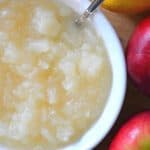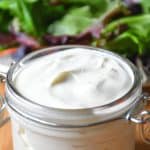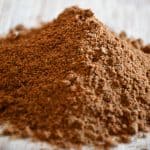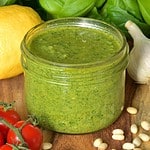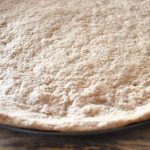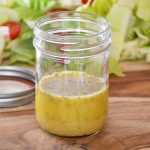Pizza is one of the most popular foods in the world. Although the word pizza doesn’t usually conjure up the idea of a healthy meal, know that it entirely depends on the ingredients used to put it together. So here’s a low sodium whole wheat pizza dough recipe to help you make your own healthy pizzas.
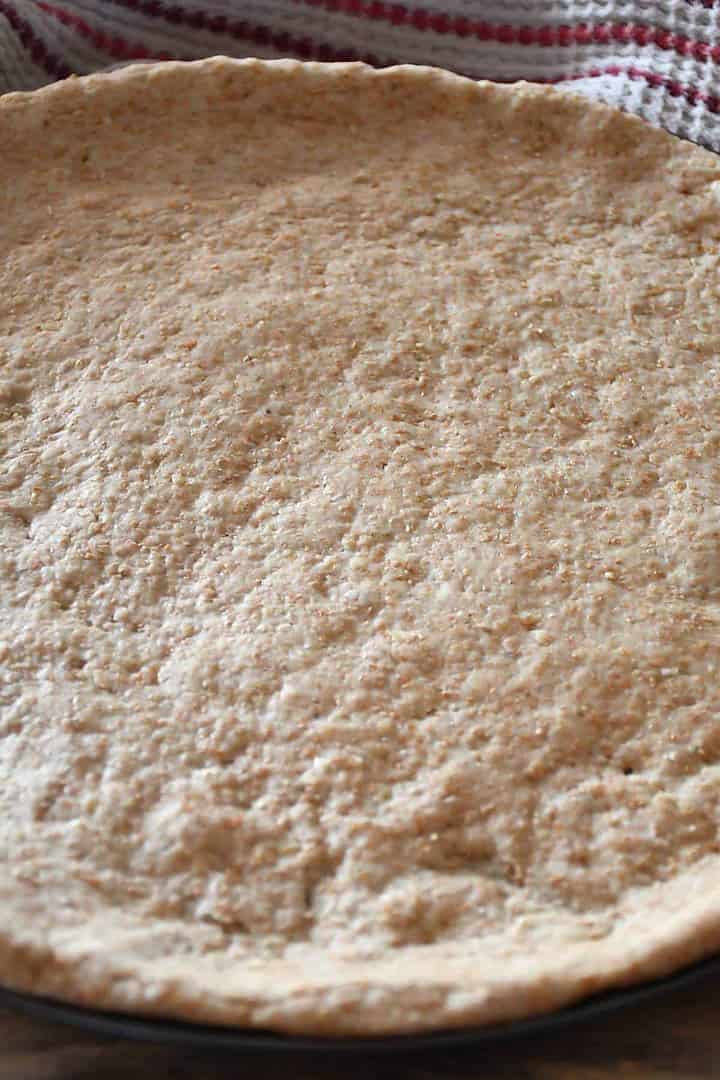
Renal nutrition
This whole wheat pizza dough recipe has no added salt. Additionally, using whole-grain flour is more nutritionally beneficial than all-purpose flour. It contains more fiber, vitamins and minerals.
Note that pizza dough made with whole wheat flour is a little denser than traditional pizza dough. If you are not used to consuming pizza dough made with whole wheat flour, it is possible to substitute some of it with unbleached all-purpose flour.
Nutrition facts and claims
Here are the nutritional values and claims of this recipe.
For informational purposes only.
Ingredients
Lukewarm water
To make pizza dough, you need water. For this recipe, you need water heated to a temperature ranging from 40°C (105°F) to 46°C (115°F). Lukewarm water is used to activate the yeast.
Maple syrup
Yeast must feed on sugar to make the dough rise. For this recipe I choose to use maple syrup. However, it is possible to replace it with the same volume of sugar or honey.
Instant yeast
Yeast is used to make the dough rise. There are several types of yeast, but the advantage of instant yeast is that it is very easy to use.
This type of yeast does not require rehydration before use. However, to make sure the yeast is still useable, I always test it with lukewarm water and maple syrup. This helps avoid to throw away a dough that does not rise.
Whole wheat flour
This recipe uses only whole wheat flour. You can use white whole wheat flour. The nutritional properties are the same, but the taste of wheat is much less pronounced, and the color is closer to that of bleached flour.
Oat bran
This low sodium whole wheat pizza dough uses oat bran. Oat bran makes the dough more tender and adds soluble fiber. It’s one of many nutritional tips used in the Santé rénale – 21 jours de menus cookbook.
If you don’t have oat bran, you can substitute the same amount of ground flaxseed or whole wheat flour.
Olive oil
The oil helps keep the dough softer and adds flavor. It is possible to use other types of oil if desired.
Dried herbs (Optional)
For more flavor, it is possible to add herbs and other aromatics to your dough. You can add any type of dried herbs or spices such as onion powder and garlic powder. You can also use a salt free Italian seasoning.
Cornmeal (Optional)
Cornmeal is optional. You can use it to sprinkle the cooking surface and prevent the dough from sticking to it. It also adds flavor and crispness.
How to make your whole wheat pizza dough
Starting mix
The first step is to mix the hot water with the yeast and maple syrup in a large bowl. You must then let this mixture rest for 5 to 10 minutes and make sure that it becomes foamy, and therefore that the yeast is good and activated.
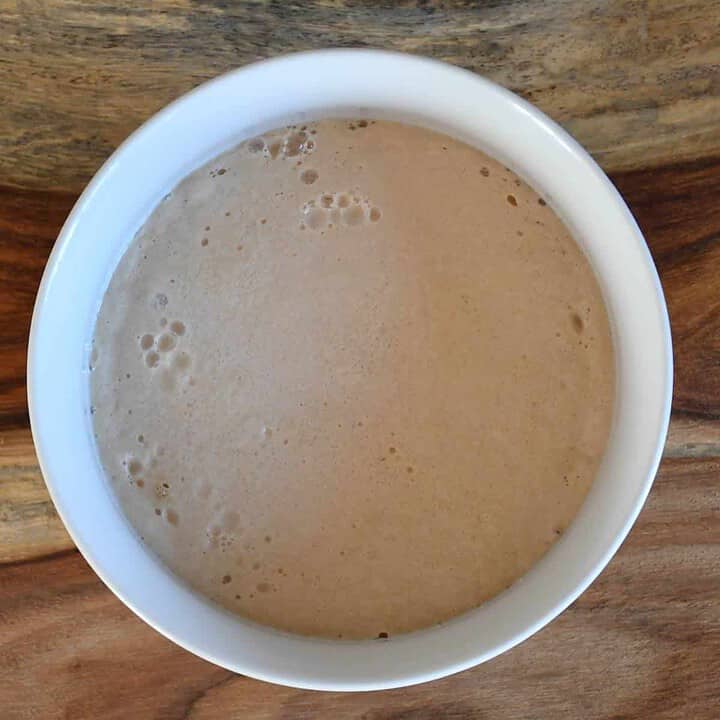
Dough mix
Then add the oil and oat bran to the liquid mixture. Once done, you must then add the whole wheat flour and mix well until you get a homogeneous dough. This step can be done by hand or with a stand mixer.
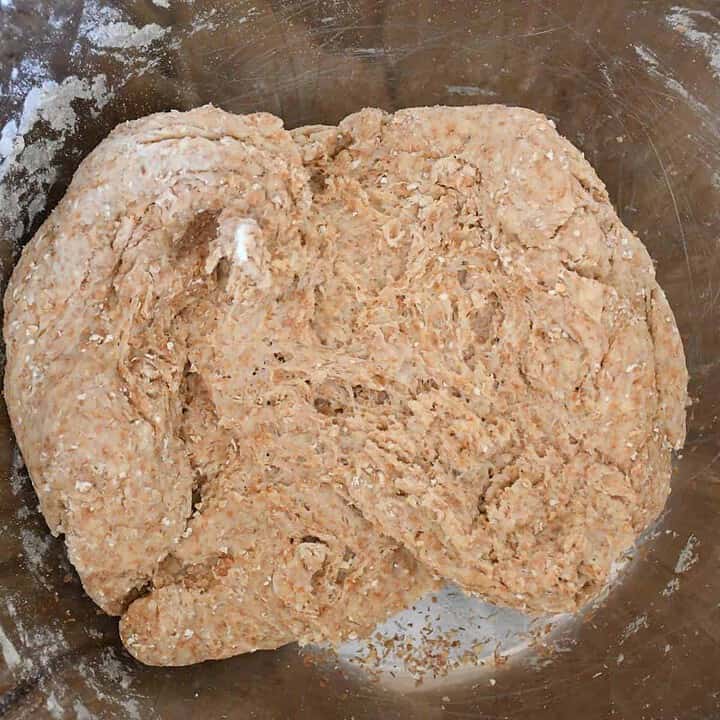
Kneading
Once the dough is ready, knead it on a floured surface. If necessary, it can be kneaded in the mixer with the dough hook at minimum speed. You need to knead the dough until it is smooth and elastic. It takes about 5 minutes by hand.
Tips
To find out if a dough is elastic, just press it lightly with a finger. If it slowly springs back into shape, the dough is ready. Otherwise, you have to keep kneading.
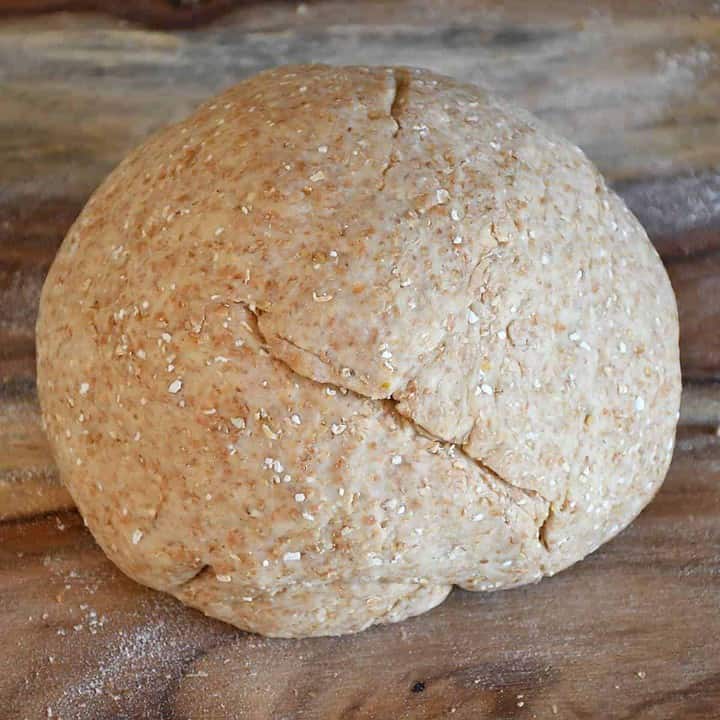
Rising
Once the dough is ready and well kneaded, simply place it in an oiled bowl and roll it to coat it with a thin layer of oil. Then cover the bowl with plastic wrap or a clean kitchen towel.
This low sodium whole wheat pizza dough only requires one rising period of about 1 hour, or until doubled in size. Once made, you can use the dough immediately or store it in the freezer.
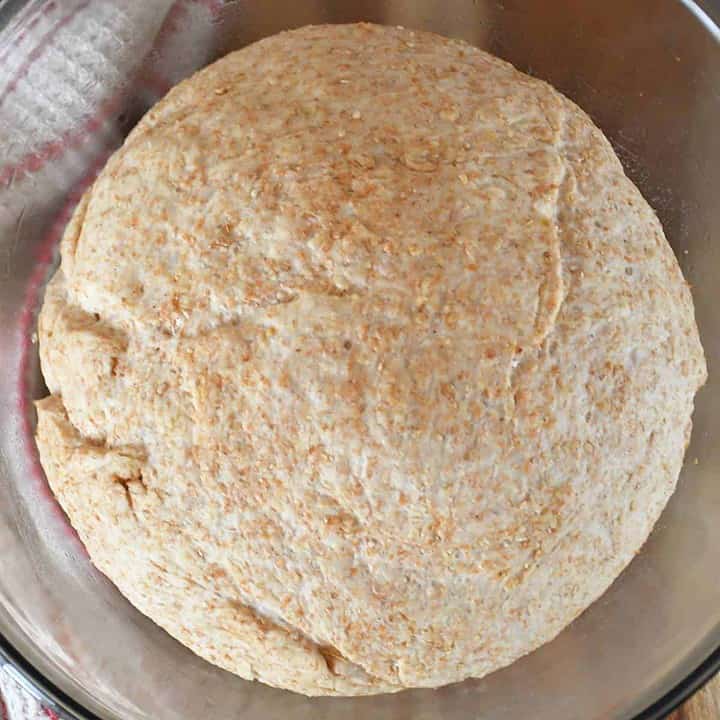
Tips
If you want to let your dough rise overnight, or let it rise early in the morning so it’s ready in the evening, just let it rise in the fridge for 8-10 hours.
Once out of the refrigerator, if your dough has not completely doubled in size, you just need to let it continue to rise at room temperature for a few moments.
How to use the dough
Once the dough has risen, it must be folded down to degas it. Next, you need to divide your dough according to use. In the case of this recipe, the dough can be divided into 2 balls of dough. One ball will allow you to make a thin-crust pizza dough about 12 inches (30 centimeters) in diameter. You can also use the entire dough to make a larger pizza with a puffy crust if you wish.
Then you can either freeze or use your dough balls to make pizza.
Make a pizza
To make your pizza, you must shape your dough on a floured surface. To do this, you must flatten it into a disk shape and then stretch it by hand or with a rolling pin. To get a crust, lightly pinch the edges of your dough.
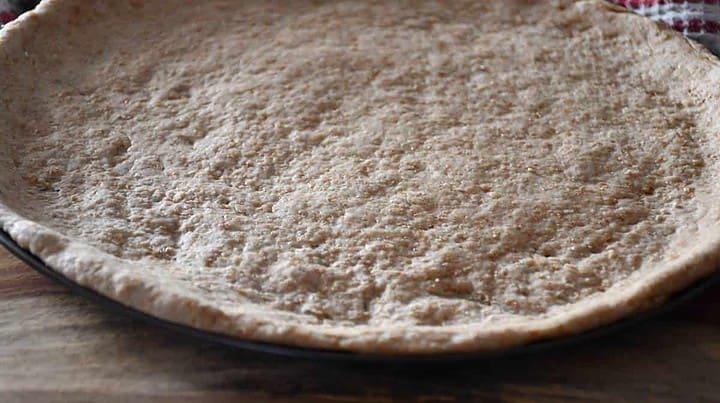
Then roll out your pizza dough on a baking sheet or pizza stone. You can also give your dough a rectangular shape and bake it on a baking sheet.
This is optional, but before placing the dough on a baking sheet or stone, you can sprinkle the cooking surface with cornmeal. This will add flavor, a bit of crunch, and keep the batter from sticking to the cooking surface.

Freezing
To freeze pizza dough, coat your balls of dough with a thin layer of olive oil and put them in airtight freezer bags, making sure to remove as much air as possible. You can also individually wrap your dough balls with plastic wrap. It is possible to keep this dough in the freezer for up to 3 months.
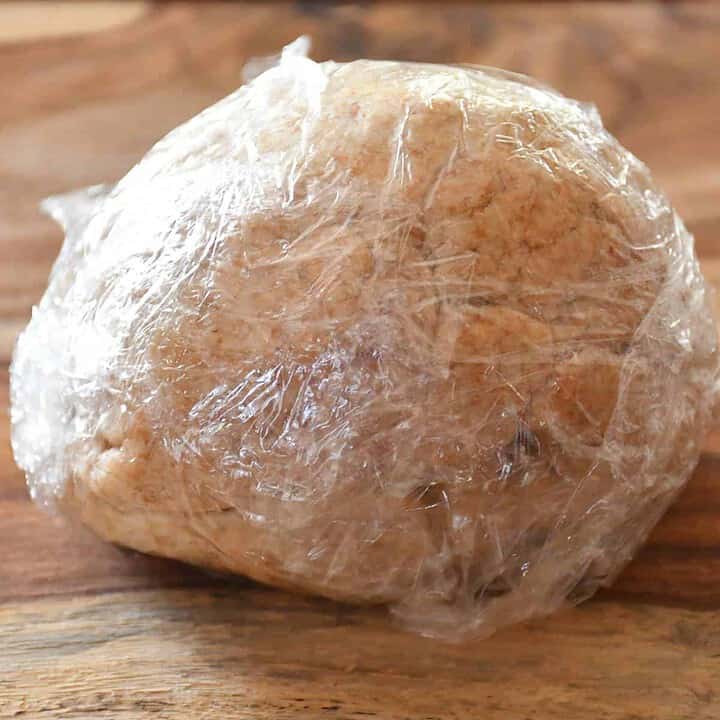
Additional recipes
Here are additional recipes for making your own kidney friendly homemade pizza with this low sodium whole wheat pizza dough.
(Available shortly)
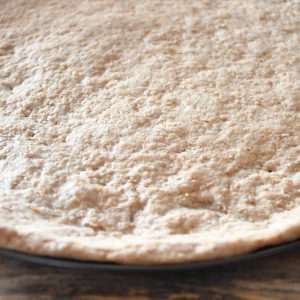
Low sodium whole wheat pizza dough
INGREDIENTS
- 1 cup + 2 tbsp lukewarm water (40℃ à 45℃ / 105℉ à 115℉)
- 2 tbsp maple syrup , honey or sugar
- 2 tsp instant yeast (1 paquet of 7g)
- 2½ cups whole wheat flour
- ½ cup oat bran
- 2 tbsp olive oil
INSTRUCTIONS
- In a large bowl, combine 1 cup lukewarm water, maple syrup and instant yeast. Let stand 5 to 10 minutes or until mixture is foamy. (Note 1)
- Add the oil, flour, oat bran and mix everything well with a wooden spoon or a silicone spatula to obtain a homogeneous dough. If the dough seem too dry, add 1 or 2 additional tbsp of water.You can also use a mixer with a kneading hook at minimum speed.
- Knead your dough by hand in the same bowl or on a floured surface for about 5 minutes. You need to knead it until it is soft and elastic. An elastic dough slowly springs back into shape when lightly pressed.You can also knead the dough using a mixer fitted with a kneading hook. Knead the dough on low speed for about 3 to 4 minutes.
- Place your ball of dough in a clean, lightly oiled bowl. Gently roll it around the sides of the bowl to coat it in a thin layer of oil and cover the bowl with plastic wrap or a clean towel.Let dough rise at room temperature for 1 hour or until doubled in size. (Note 2)
- Degas your dough and separate it into 2 equal parts. Depending on your needs, you can separate your dough differently.From this step, you can choose to freeze it or use it immediately. The following steps are for informational purposes. (Notes 3 and 4)
If freezing
- If you want to use all of your pizza dough immediately, skip to the next step.To freeze pizza dough, form one or more round balls of dough, coat them with a thin layer of olive oil and wrap them individually in plastic wrap or a resealable bag, taking care to remove the most air possible. This dough can be kept for about 3 months in the freezer.
If baking
- Preheat the oven to 400℉ (200℃).
- Use a ball of dough and shape it into a disc about 12'' in diameter. You can form a crust by lightly pinching the edge.
- Place your desired toppings on your dough, such as low sodium pizza sauce, vegetables, a source of protein, etc.For a crispier crust, I suggest brushing a small amount of olive oil on it. (Optional)
- Bake for about 20 to 30 minutes, until the crust and toppings are cooked through. The temperature and cooking time may vary depending on the filling chosen and the thickness of your dough.
NOTES
NUTRITION FACTS
For informational purposes only. Nutrition data is primarily calculated from the USDA National Database. Values may vary from accuracy of measurements, brands, nutritional data and more. All measurements are metric (1 cup = 250ml). Readers are encouraged to make their own calculations.


